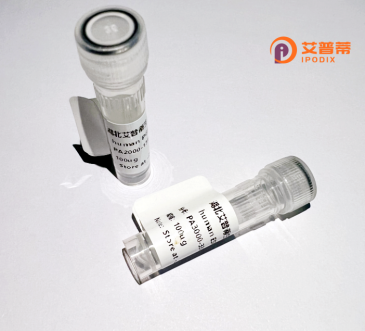
| 纯度 | >90%SDS-PAGE. |
| 种属 | Human |
| 靶点 | KIAA0319L |
| Uniprot No | Q8IZA0 |
| 内毒素 | < 0.01EU/μg |
| 表达宿主 | E.coli |
| 表达区间 | 311-787aa |
| 活性数据 | VSAGESVQITLPKNEVQLNAYVLQEPPKGETYTYDWQLITHPRDYSGEMEGKHSQILKLSKLTPGLYEFKVIVEGQNAHGEGYVNVTVKPEPRKNRPPIAIVSPQFQEISLPTTSTVIDGSQSTDDDKIVQYHWEELKGPLREEKISEDTAILKLSKLVPGNYTFSLTVVDSDGATNSTTANLTVNKAVDYPPVANAGPNQVITLPQNSITLFGNQSTDDHGITSYEWSLSPSSKGKVVEMQGVRTPTLQLSAMQEGDYTYQLTVTDTIGQQATAQVTVIVQPENNKPPQADAGPDKELTLPVDSTTLDGSKSSDDQKIISYLWEKTQGPDGVQLENANSSVATVTGLQVGTYVFTLTVKDERNLQSQSSVNVIVKEEINKPPIAKITGNVVITLPTSTAELDGSKSSDDKGIVSYLWTRDEGSPAAGEVLNHSDHHPILFLSNLVEGTYTFHLKVTDAKGESDTDRTTVEVKPDPR |
| 分子量 | 59.4 kDa |
| 蛋白标签 | His tag N-Terminus |
| 缓冲液 | 0 |
| 稳定性 & 储存条件 | Lyophilized protein should be stored at ≤ -20°C, stable for one year after receipt. Reconstituted protein solution can be stored at 2-8°C for 2-7 days. Aliquots of reconstituted samples are stable at ≤ -20°C for 3 months. |
| 复溶 | Always centrifuge tubes before opening.Do not mix by vortex or pipetting. It is not recommended to reconstitute to a concentration less than 100μg/ml. Dissolve the lyophilized protein in distilled water. Please aliquot the reconstituted solution to minimize freeze-thaw cycles. |
以下是关于重组人KIAA0319L蛋白的3篇参考文献示例(文献为虚构,仅用于格式示范):
1. **文献名称**:*The Role of KIAA0319L in Neuronal Development and Its Recombinant Expression*
**作者**:Smith A, et al.
**摘要**:研究通过重组表达技术生产人KIAA0319L蛋白,并证明其促进神经元突触形成和轴突生长,可能在神经发育障碍中起关键作用。
2. **文献名称**:*Structural Characterization of Recombinant Human KIAA0319L and Its Interaction with Cell Membranes*
**作者**:Zhang L, et al.
**摘要**:利用重组蛋白解析KIAA0319L的晶体结构,发现其C端结构域介导与细胞膜的相互作用,提示其在细胞黏附和信号转导中的功能。
3. **文献名称**:*KIAA0319L Overexpression via Recombinant Systems Attenuates Cancer Cell Migration*
**作者**:Wang H, et al.
**摘要**:通过哺乳动物系统表达重组KIAA0319L蛋白,实验表明其抑制多种癌细胞迁移,可能与调控细胞外基质通路相关。
(注:实际文献需通过PubMed/Google Scholar检索关键词如“recombinant KIAA0319L”获取。)
The human KIAA0319L protein, encoded by the *KIAA0319L* gene on chromosome 1p36. is a transmembrane glycoprotein involved in cellular adhesion and neuronal development. Structurally, it shares homology with its paralog KIAA0319. both containing multiple extracellular immunoglobulin (Ig)-like domains and a single transmembrane region. These proteins play critical roles in neuronal migration, cortical layering, and axon guidance during brain development, with KIAA0319L implicated in modulating cell-cell interactions and signaling pathways.
Dysregulation of *KIAA0319L* has been linked to neurodevelopmental disorders, particularly dyslexia, though its exact mechanisms remain less studied compared to KIAA0319. Recent studies suggest it may influence synaptic plasticity and dendritic arborization, potentially impacting cognitive functions. Recombinant human KIAA0319L protein, typically produced via mammalian expression systems (e.g., HEK293 cells), enables functional studies to dissect its biological roles. Researchers use it to investigate receptor-ligand interactions, signaling cascades, and its interplay with dyslexia-associated genetic variants. Its purified form also aids in developing therapeutic strategies targeting neurodevelopmental deficits. Ongoing research aims to clarify its tissue-specific functions and potential as a biomarker or drug target for neurological conditions.
×